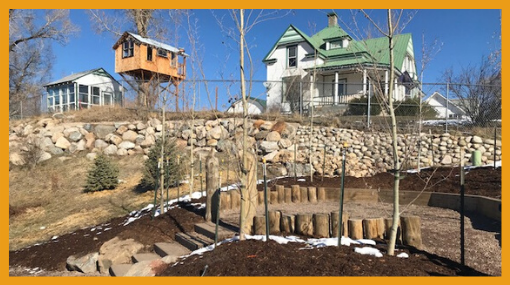The health of the trees and shrubs planted near Soda Creek Elementary School in Steamboat Springs, Colorado, was a decidedly mixed bag. “Anyone driving by could see that some trees and shrubs originally planted were thriving, while others were dead or dying, and others were damaged by student misuse,” said fifth-grade teacher Natalie Sattler.
In the fall of 2017, Sattler and second-grade teacher Cindy Gantick (since retired) decided to engage their students in a joint project to improve the soil and trees at this relatively new school site. But as they became more involved, the project’s scope grew.
 Starting with Soil Science
Starting with Soil Science
The combined classes started with research, including taking inventory of the existing trees and native vegetation on the property. Early sessions included background reading, in which the older and younger students worked together—a lesson in how to work across the different age levels. Students even learned about effective soil sampling with help from a parent and professor at Colorado Mountain College, who analyzed the results, and found that the shallow, low-quality topsoil could not sustain long-term growth of many of the trees planted.
Students armed themselves with this knowledge and devised a path forward. With many feeling scared and stressed by nationwide violence in schools, the idea formed to create a peace garden and outdoor classroom where students could have mindful reflective time and teachers could have a more comfortable space for outdoor lessons. The students identified an area for improvement that could serve as a good site for these purposes and got to work.
As the project’s scope grew from its data-gathering origins, it needed to fit what the students could feasibly accomplish. Originally, the teachers planned to have the students use ARCView/GIS as a mapping and planning tool, but it soon proved too complex for the fifth graders. Initial brainstorming ideas also included a fishpond and water slide, but ultimately, the students proposed a learning space featuring native plants and trees, and a painted mural of native vegetation on an existing wooden fence created by the art teacher and students.
 Community Collaboration
Community Collaboration
“The scope of the project grew exponentially, as did the time commitment to finish it,” Sattler said. “There were many long hours spent during work sessions before the snow fell on the trees that were planted. Students learned the process of making a difference in their community.”
Master Gardeners, local families, the Colorado State Forestry Service, and many others helped—including local businesses, who donated much-needed time and materials, such as topsoil and use of heavy equipment. In addition to learning about soil science and other concepts, Sattler noted that each student became a leader in their own way: by making posters, asking for donations, planting and watering trees, or making sure their fellow schoolmates respected the space and knew about the purpose of the garden.
 Student Engagement and Impact
Student Engagement and Impact
“They felt part of something bigger than just themselves,” Sattler said. “They learned why native species are better to plant than non-native species, and about collecting and communicating scientific data. Many students learned how to use shovels, rakes, and wheelbarrows as they hauled donated gravel and topsoil.”
“Most of all, they learned that kids can, with some effort, make a lovely difference in their school community,” she said.
“We could probably write a book about the ins and outs of launching this project and its continuous evolution,” she continued. Her key suggestions? Find compatible local partners, foster student ownership by respecting their ideas, and include the administration.”
And finally, a good rule for much in life: “Relax into the process of a project that may need continual improvement—and breathe deep breaths often!”


